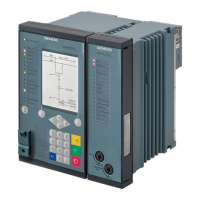current of phase currents is formed from the difference between the present current phasor and the current
phasor of the previous period. This allows to take into account a jump of the current phase.
Switching onto a 3-Phase Measuring-Voltage Failure, Low Load
Logic
[lozuscha-100611-01.tif, 1, en_US]
Figure 8-8
Logic Diagram Switching to 3-Phase Measuring-Voltage Failure
Switching onto a 3-phase measuring-voltage failure is detected if the following criteria are fulfilled simultane-
ously:
•
All 3 phase-to-ground voltages have dropped below the threshold value 3ph.fail. - VA,VB,VC <.
•
The circuit breaker is detected to be in closed position. The detection takes place either via the phase
currents or via the ≥1-pole closed signal, which is generated via the circuit-breaker auxiliary contacts.
You can find more detailed information in chapter 5.8.6 Circuit-Breaker Condition for the Protected
Object.
A voltage jump – such as in a 3-phase measuring-voltage failure with closed circuit breaker (see
chapter8.3.2.4 3-Phase Measuring-Voltage Failure ) – does not occur in the case of switching to a 3-phase
measuring-voltage failure. If the monitoring is not blocked, the time delay SO 3ph.fail. - time delay
is started. After the time has elapsed, the indication SO 3ph.failure-alarm is displayed. A dropout of the
monitoring is only possible by a recovery of the voltage.
The supervision is blocked as soon as a pickup of a protection function is detected within a protection function
group and the time delay of the supervision has not yet elapsed.
This subfunction also covers the situation of a low load with 3-phase measuring-voltage failure and closed
circuit breaker, because the circuit-breaker condition is also determined from the circuit-breaker auxiliary
8.3.2.5
Supervision Functions
8.3 Supervision of the Secondary System
942 SIPROTEC 5, High-Voltage Bay Controller, Manual
C53000-G5040-C015-9, Edition 11.2017

